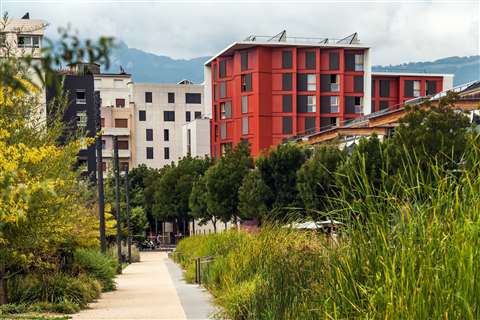The countries that are amending building codes to limit construction carbon emissions
06 April 2023
CO2 emissions from building and construction have hit a new high, leaving the sector off-track to decarbonize by 2050, according to a recent UN report.
 Image: Jesse B/peopleimages.com via Adobe Stock
Image: Jesse B/peopleimages.com via Adobe Stock
But a small but growing number of countries have either implemented or are preparing to introduce changes to their building codes to limit the emissions created by a building not just while it is in use, but during the construction phase as well.
In some cases, new or planned regulations extend to the carbon embodied in building materials and the emissions generated transporting them.
With as much as a quarter of building-related emissions estimated to come from the construction phase once the embodied carbon in materials is included, these early adopter countries stand as exemplars of a practice that the UN has urged governments to adopt far more widely in their efforts to limit global warming.
Meanwhile other countries are facing a call to do more.
Harpa Birgisdóttir, professor, research group on sustainability of buildings at Aalborg University Copenhagen in Denmark says, “Evidence from whole-life cycle carbon assessments of buildings shows increased importance of embodied carbon in building materials and components. In order to reduce the embodied carbon in materials, new requirements need to be introduced with limit values based on whole-life carbon assessments.
“We must start introducing requirements worldwide that also embrace the embodied carbon, as has already been implemented or agreed in the Netherlands, France and Denmark, and planned in Finland and Sweden.”
Birgisdóttir, who has co-authored a report called Towards embodied carbon benchmarks for buildings in Europe, also stresses the importance of regularly strengthening the limit on carbon emissions in order to close the gap between the emissions today that are largely overshooting the Paris agreement carbon budget.
Denmark
At the start of this year, Denmark became the first Nordic country to set a requirement in building codes to document the environmental impact of new buildings over their entire lifecycle.
Up until recently, environmental legislation has targeted the energy consumed in a building only while it is in use.
But the new Danish requirements mean that construction companies must create life cycle assessments (LCA) showing the environmental impact of a new building over a period of 50 years.
New buildings above 1,000 sq m must also comply with a carbon emissions limit of 12kg of CO2 per square metre per year.
That limit will further reduce in 2025 and will also start to apply to smaller buildings.
The LCA reports on all phases of a buildings construction, from the emissions embodied in raw materials to transport, through to the construction and operation. It involves a series of complex calculations that place greater demands on suppliers and construction companies.
Finland
Alongside other Nordic countries, Finland is working towards carbon neutrality by 2035, ahead of the European Union goals of reaching net zero by 2050.
The country is developing legislation for low-carbon construction, which will involve setting carbon limits for different building types by 2025.
The limits will be supported by an emissions database similar to France’s INIES database, which covers construction products and materials as well as sources of energy, transportation methods, and site operations and waste management.
In September last year, the government approved proposals for a new Building Act, coming into force at the start of 2024.
It will lay down the requirements for low-carbon buildings and their life cycle. It will allow the government to issue new decrees concerning climate and materials declarations on buildings and limit values for the carbon footprint. The government is preparing the decrees, which will be included in the National Building Code of Finland.
France
France has already introduced regulations applying to newly built developments, called RE2020, that govern both operational and embodied carbon.
 The eco district of ‘Bonne’ in Grenoble, France (Image: krugli via Adobe Stock)
The eco district of ‘Bonne’ in Grenoble, France (Image: krugli via Adobe Stock)
They are based on a dynamic life cycle analysis (LCA), which weights future emissions less than current emissions. They are part of a plan to halve carbon emissions related to the building sector by 2030 (as compared to 2015), before creating a fully net zero building sector by 2050.
Introduced in 2022, RE2020 initially applied to all new housing projects and has since extended to office buildings. It requires projects to meet targets including optimizing the overall energy consumption involved in the construction and operation of a building, reducing primary energy consumption, reducing the climate impact of the materials used during construction, and limiting heat discomfort in buildings during summer.
The rules mean that project managers will have to file declarations that the buildings comply with the limits defined by the government as part of a building permit application. Meanwhile, a qualified professional will also have to sign a confirmation that the building meets requirements at the end of construction.
The carbon emissions thresholds under the RE2020 regulations have been designed to be reduced gradually over time, falling by 15% in comparison to 2022 by 2025, then by 10% compared to 2025 in 2027, and another 15% in comparison to 2027 by 2031. Overall, that would lead to a fall in carbon emissions thresholds of 52% by 2031, as compared to 2022.
Base thresholds under France’s RE2020 regulations
| kgCO2eq/m2 | 2022-2024 | 2025-2027 | 2028-2030 | 2031 and beyond |
| Individual and terraced housing | 640 | 530 | 475 | 415 |
| Apartments | 740 | 650 | 580 | 490 |
In order to allow designers to make informed choices about what materials and products to use to keep new buildings under the thresholds set by RE2020, they will be able manufacturers’ environmental declarations, listed on Frances INIES database. The database contains nearly 4,000 datasheets relating to construction products.
The Netherlands
The Netherlands is thought the have been the first country to have introduced limits on the embodied carbon in new buildings via its building regulations.
Since 1 January 2021, permits for all new types of construction – both residential and non-residential – have to meet the requirements for ‘Nearly Energy-Neutral Buildings’ (BENG).
New Zealand
New Zealand has proposed making a series of amendments to its Building Act to introduce energy ratings for buildings and waste minimisation plans.
The proposed amendments would change the principles and purposes of the Building Act to clarify that climate change is a “key consideration”.
It aims for all buildings built after 2030 to have “the lowest possible whole of life embodied carbon and operational emissions near zero”.
By 2024, it aims to update the building code to set a foundation for emissions reporting and capping new buildings emissions.
Following in 2025, it has proposed a building materials database, carbon calculation tools and a data repository.
The country plans to tackle both operational efficiency and the whole of life embodied carbon in buildings. It aims to set new reporting requirements for operational emissions and embodied emissions in new buildings by 2025. A phased lowering of caps for both operational efficiency and embodied emissions will follow in 2026-29.
STAY CONNECTED



Receive the information you need when you need it through our world-leading magazines, newsletters and daily briefings.
CONNECT WITH THE TEAM








